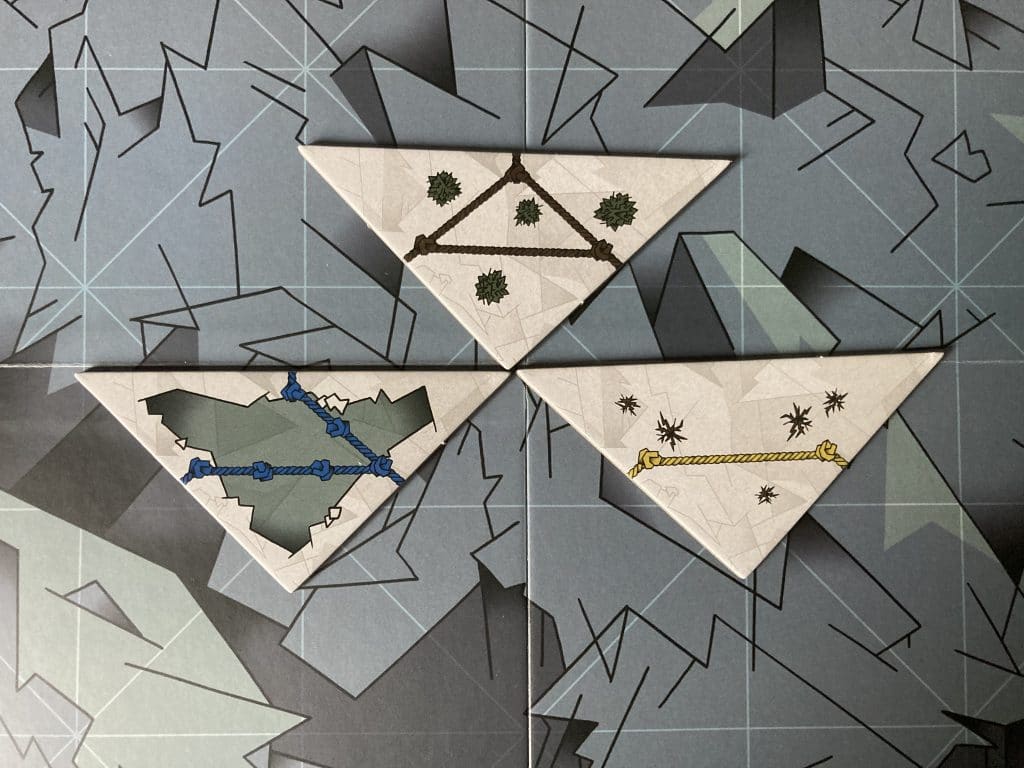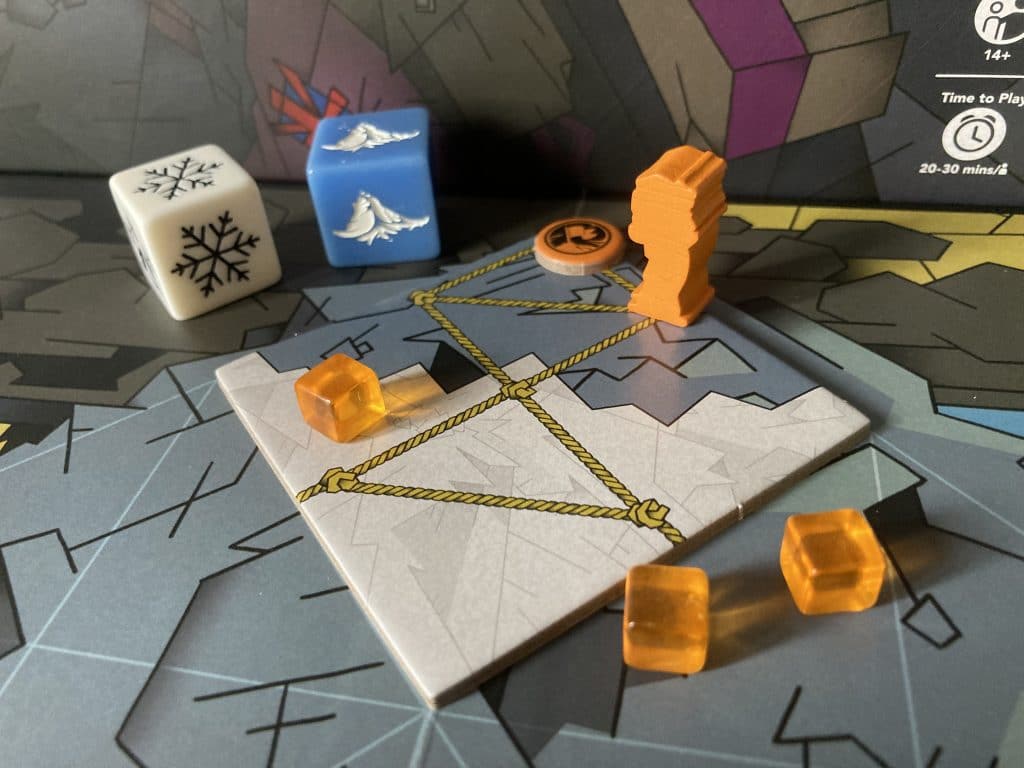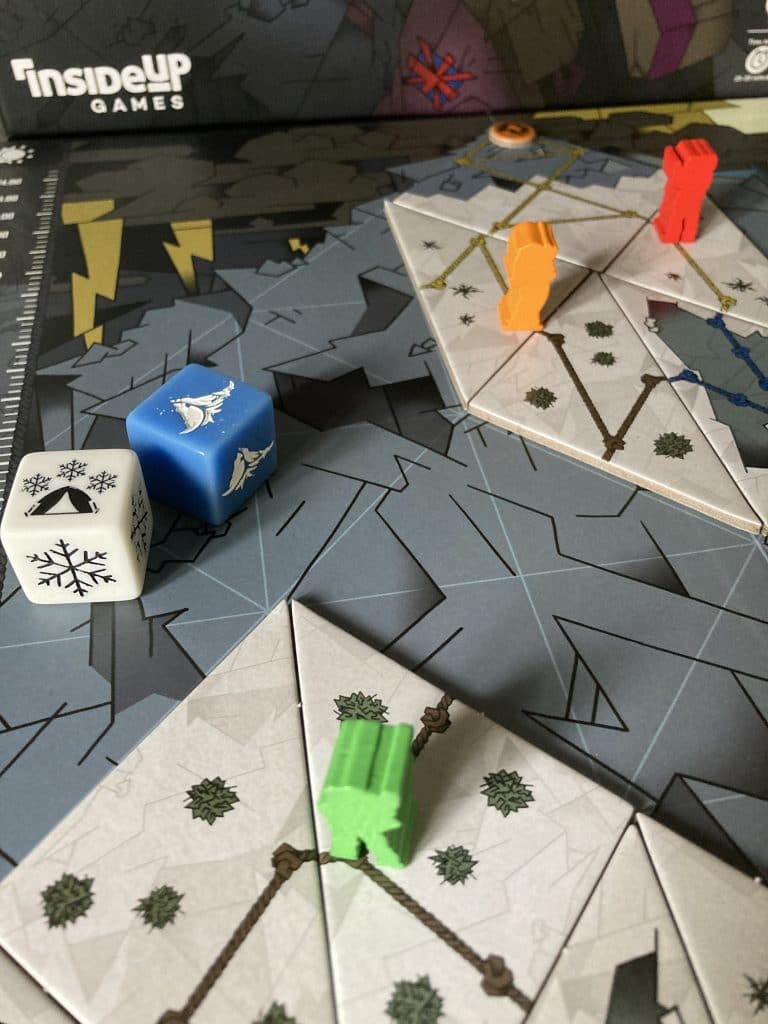There are plenty of really good cooperative board games out there. In fact, we compiled a Top 7 list a few years ago, and many of those titles still stand firm in the genre.
But, we really should make an updated list to include some more recent games. A definite inclusion of mine would be Summit: The Board Game, designed by Conor McGoey and published by Inside Up Games. It’s a game about the harsh realities and trials of climbing a mountain, something I know next to nothing about because I have a fear of heights.
Luckily, my fear of high places has no adverse impact on enjoying Summit! There’s plenty to like about the game, which I’ll divulge in my review below.
So grab your packs and let’s get to the top of this review!
Summit: The Board Game Gameplay
First thing’s first, Summit: The Board Game contains three different modes to enjoy. You can scale the peak by yourself in a solo game, conquer the mountain with a group in a cooperative mode, or race to the top in the competitive mode.
Summit: The Board Game combines tile-laying with an action-selection system as players assume the roles of Mountaineers ascending a mountain. Each climber has their own unique Character Mat, which defines how the weight of their gear impacts their movement, and their capacity for supplies.
In the cooperative game, the goal is for as many climbers to summit the mountain and successfully return to basecamp as possible. Unfortunately, everyone will be fighting the mountain and the weather with every passing hour, and the journey can be fatal.
Players have a couple options on their turn. First, they can perform one of the following actions:
- Move up your movement rating and place tiles as needed for your character’s movement
- Skip movement to discard your Tile Hand and draw up the Tile limit
- Skip movement and attempt to remove a card or token from your character mat
- Skip movement and give, take, or exchange supplies with your Sherpa(s)
As you can see, movement is a very important aspect of the game. Without it, you can’t win! Therefore, managing when it’s necessary to sacrifice that movement plays a pivotal part in your strategy.
After taking an action, players will then roll the Event Die and the Weather Die. Once every player has gone in a round, the Time of Day marker gets moved up one space.
The Event Die determines if a player will draw an Event Card. These cards can do any manner of things, both positive and negative. For example, you might have a card that allows you to take a tile and put it into play. Or you could be forced down the mountain by a landslide. You never know what you’re going to get!
The Weather Die determines whether the climbers are going to have a bout of sunshine, a blizzard, or any amount of snow in between. As the Blizzard Marker moves up, players need to expend more rations to withstand the elements. If players are out of Oxygen and Rations, they begin to take Health damage until they perish on the peaks.
Staking Our C.L.A.I.M. on Summit: The Board Game
![]() Components
Components
Upon opening the box, I was pleasantly surprised by the quality of the components in the box. Everything fits back nicely and easily in the box thanks to a well-designed insert, with a designated place for the tiles, character mats, tokens, player pieces, and cards.
Anytime I get to play with a double-layered board, I am the happiest of campers! It’s my number one upgrade that can take good components to an exceptional level. The Character Mats are double-layered, which is most welcomed, especially with all the moving of cubes that you’ll be doing. Now, it’ll take a bit more force to knock that cube out of position.
The various tiles that you’ll use to create the mountain landscape are a solid thickness as well. You won’t find anything in the box that’s flimsy or under-produced. Inside Up Games could have easily gone with a thicker cardboard for some components, but they decided on a uniform thickness for everything.
Player pieces are a blend of semi-opaque acrylic cubes, a wooden Karma marker and Mountaineer meeple, and cardboard flag tokens. Each of the Mountaineer meeples are in their own unique pose, which couples well with their asymmetric boards.
As for the two dice, they are engraved and painted. Again, this is a step up from just printing on the die face; it brings more longevity to the lifespan of the components.
You’re also getting two separate rulebooks, depending on if you’re playing Competitively or Cooperatively/Solo. This makes it much easier to focus on what’s important for your specific game.
If I had to find an issue with the components overall, it would be the layout of the rulebook. There’s a lot of text and repetitive iconography. Plus, there are some parts of the rulebook where the artwork seems to be cutoff, which I can’t tell if that’s intentional or not.
Additionally, there are some aspects of the rules that are difficult to find. For example, there isn’t a section for the Time of Day track; the rules for time are under Step 13 of the Setup and not mentioned anywhere else. I would have expected there to be something mentioning time in the Turn Overview section, but there isn’t.
One nice thing about the rulebook is that there are plenty of ‘asides’ marked in blue boxes that help provide rules context or answer questions that you may have had about specific rules. There is also a ‘Fast Play Setup’ instruction on page 11 that helps you get rolling with your game by giving you starting Character/Item combinations. This was really nice to have for the first couple plays.
![]() Luck
Luck
I’m mostly going to focus on the strategy of Summit: The Board Game from the perspective of a cooperative game, as I think the game lends itself best to that particular mode. The theme of mountain climbing seems to work a bit better when everyone is all aligned towards a group-orientated goal, especially when it’s a matter of life or death for the characters.
As I mentioned above, players are usually in a quandary of whether or not they should give up their precious movement to do something else. Every time I gave it up, I found myself strained with the decision!
Let’s say you give up your movement to get some more oxygen and food from your Sherpa. After that, you draw a negative Event card and you roll Heavy Snow on the Weather Dice, forcing you to eat some of the rations you just traded for. In that turn, you now made no progress towards your goal, instead losing some or all of the rations you just traded for. It can be brutal!
Another interesting bit of strategy comes in the usage of Items and Starting Equipment. These allow you to do exceptional things during your turn that have a great impact on the game. For example, the Ice Axe allows you to ignore movement caused by an Event (presumably a negative one). Or, you might have Crampons that give you some much-needed extra movement over Ice Tiles.
There are also plenty of ways that you can increase or decrease the difficulty, which is a staple of cooperative games. I really like the design choice to use mountaineering difficulty icons as the game difficulty icons, with triple black diamond being the hardest experience.
If you are looking for other ways to increase the difficulty other than the ones mentioned in the rulebook, you can always institute your own rules like limiting what a Sherpa can carry or starting with a single Item.
Overall, Summit: The Board Game gives a really nice risk/reward style of game that punishes players for getting too optimistic. Just like climbing, the situation in the game can change in an instant, and you have to be ready for anything.
![]() Aesthetics
Aesthetics
Summit: The Board Game has a very unique art style that I would consider to be polarizing. Don’t get me wrong; the art is very good and it’s cohesive across the entire product. However, I can see how some people might not like the sharp lines and angular quality to the style.
Personally, I think the somewhat jagged aspect of the art helps tie it to the theme. When we’re talking about mountain climbing, we need to consider that rocks on the mountain aren’t typically going to be rounded and smooth. There are sharp edges that make traversing a mountain difficult. That’s what all the lines and angles remind me of, so I consider it to go hand-in-hand with the theme.
I do think the box could afford to be a bit lighter to help it pop more. As it stands, three-quarters of the box are really dark, and there isn’t enough contrast to easily showcase that the game is about mountain climbing.
The unique art for each of the Mountaineers is really good. It’s always nice to have something to reference when playing a role-based game, especially when the individual Mountaineers have specific abilities unique to them. Their personality and background really shines through.
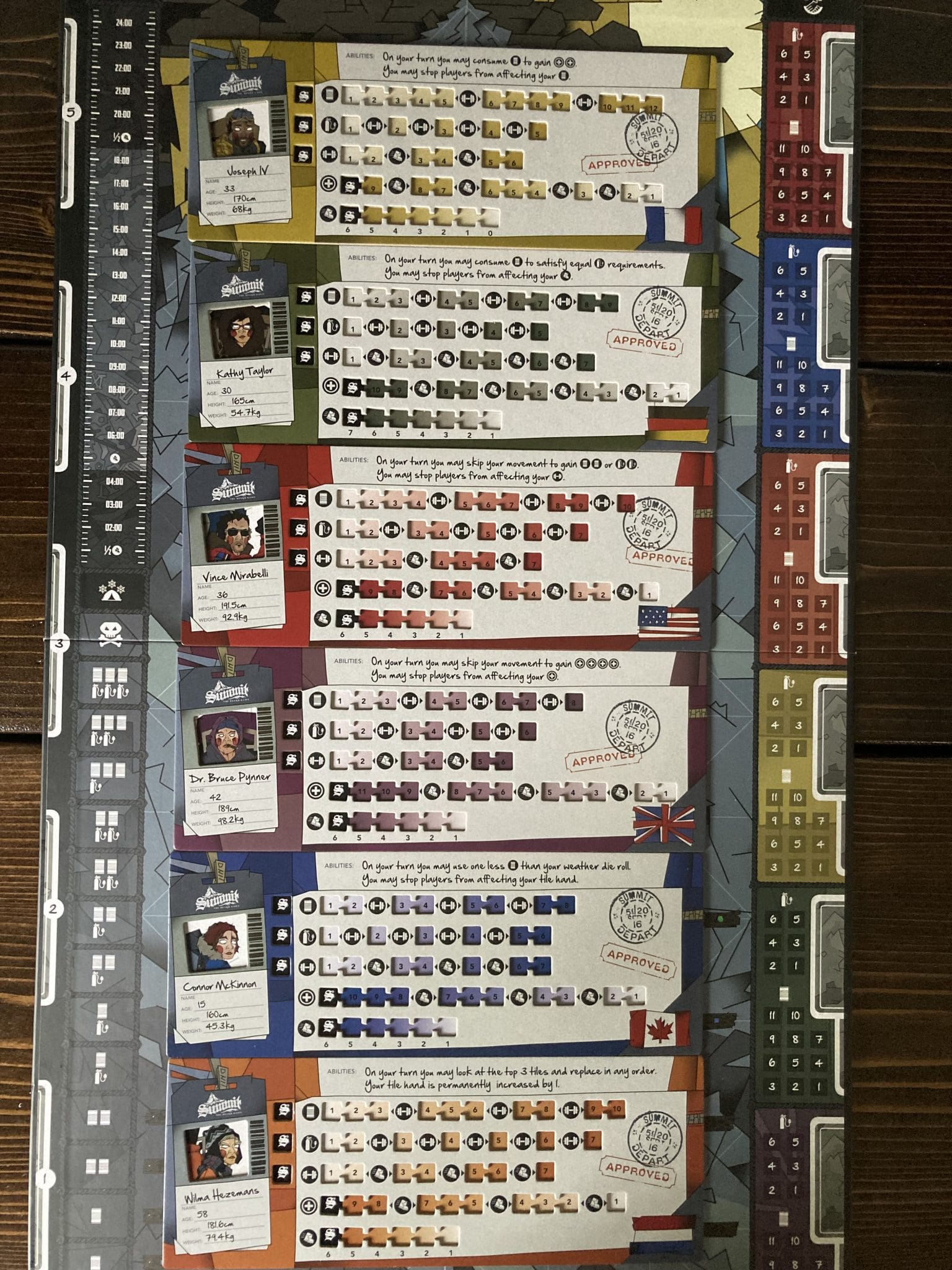

![]() Interest
Interest
Because of the three different game modes, Summit: The Board Game will appeal to all sorts of gamers. People looking for a friendly game where everybody gets to gang up against Mother Nature will flock to the cooperative mode. If you’d rather play something where you can push down other players in a race to the summit, the competitive mode will do the trick. Just don’t let karma catch up to you.
No matter how you play it, you’re always going to have that feeling of fighting against the clock. Literally, in fact, because your movement gets halved when you’re hiking in the nighttime hours. And at this point I hope I’ve hammered home the point that movement = victory.
Fans of the outdoors, hiking, or mountain climbing will be especially drawn to the theme of the game. I really don’t think the game would be the same without the randomness of the Events, either. They offer wider design space for the Items and force the players to react to the outcome.
Finally, due to variety of challenge that you can bake into the difficulty, the game can be as easy or hard as you want it to be. There’s plenty of opportunity to shape the game to be what you want it to be.
![]() Mood
Mood
Thematically, Summit: The Board Game captures the essence of mountain climbing. Well, it at least captures the essence of what I imagine mountain climbing to be like. As an avid hiker, every hike is going to present its own set of challenges and rewards, just like the game.
The gameplay design is actually quite clever. Even though I don’t climb, hiking has a similar concept that involves looking ahead and figuring out the best path forward. The modular nature of the mountain tiles do a fantastic job to convey this; sometimes the path is steep or dangerous, taking you longer to complete. Other times, the trail might take a lot out of you physically, requiring moments to catch your breath or consume supplemental oxygen.
Players will likely feel their anxiety rising as they approach nighttime or as the Avalanche Track continues to tick upwards. It really is something of a juggling act managing individual resources and the global resources as a group.
In several games, I also found myself in a better position to place tiles on the way back down instead of just using the same path that I took on the way up. Maybe it’s because I raced to the top as quickly as possible, without any care to how much oxygen I was using. Or maybe I walked through way too many Ice Tiles. In any case, the game is well-designed in the sense that it’s not always a simple down-and-back. The strategy doesn’t end when you get to the summit; that’s only half the battle.
Plus, you always have the expertise of Sherpas to rely on!
Summit: The Board Game: Peak Cooperation
There’s a lot of content packed into the box for Summit: The Board Game, meaning that you can play tons of games and get a new experience each time. If you wanted to, you could also design little scenarios by stacking the deck and arranging the tiles in a specific way to create puzzles for others to solve.
If you like Summit: The Board Game, you will be happy to know that there are two expansions to alter your Summit Experience. The Yeti expansion introduces an abominable snowman to the slopes, and the Teams expansion serves up some new gameplay elements including ladders to help traverse the slopes more easily.
Everything considered, we are happy to award Summit: The Board Game with the Nerds on Earth Seal of Awesomeness! We continue to be excited about the multiple game modes, and the strategic placement of the triangular tiles on the mountain. It’s been a challenge that we’re pumped to keep tackling. Or at least attempting to.
And, if you’re not a mountain climber, Summit: The Board Game might be the vaulting point to a new hobby!
Disclosure: Inside Up Games provided Nerds on Earth with a copy of Summit: The Board Game in exchange for an honest review.


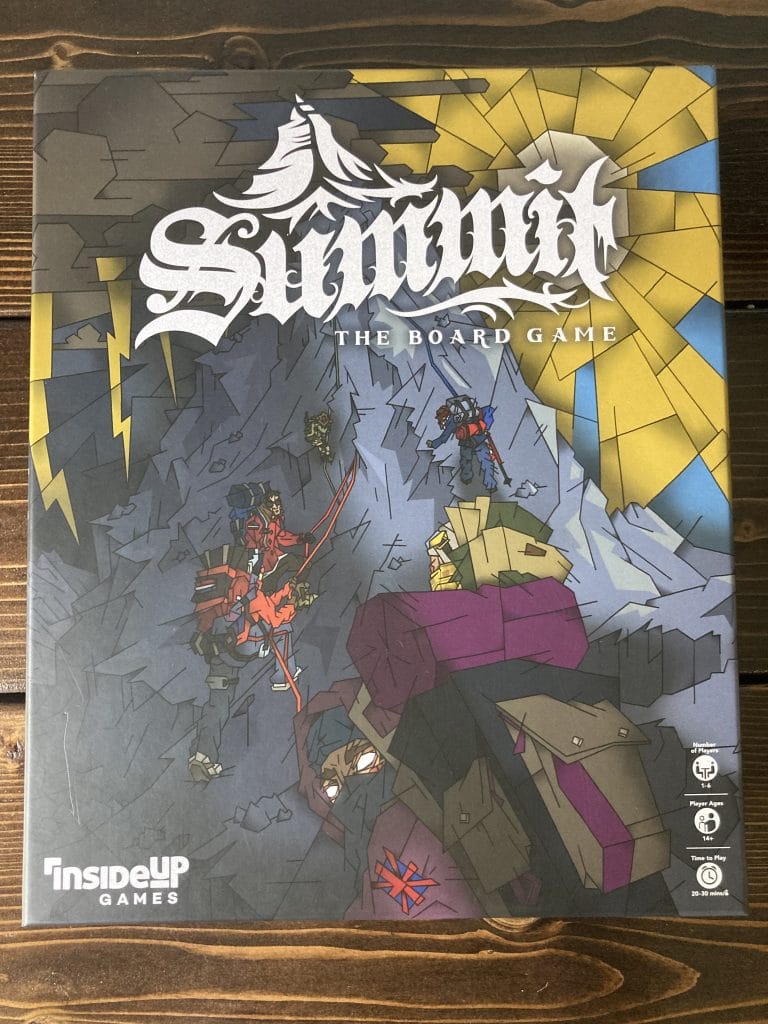
 Components
Components